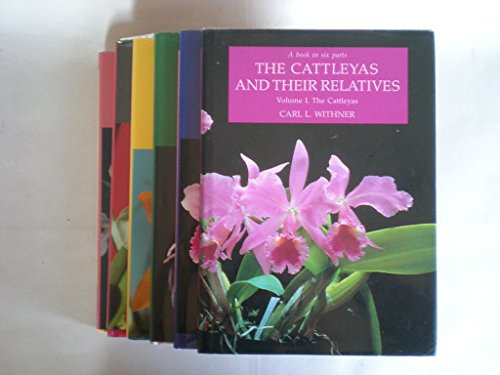
Synopsis
This volume also includes taxonomic and nomenclatural changes affecting species covered in the earlier volumes, as well as additions and changes to the text of each of the five volumes.
"synopsis" may belong to another edition of this title.
About the Author
From the Back Cover
THE CATTLEYAS AND THEIR RELATIVES
Volume VI: The South American Encyclia Species
This is the final volume in a landmark treatise in six parts devoted to the genera of the Cattleya alliance, a series whose first volume appeared in 1988. This volume covers the species of Encyclia native to South America, a group of orchids that presents the researcher with many difficulties. The herbarium record is minimal on many of these species, and the original or type specimen may have been destroyed; photographs and even drawing may be lacking. There are formidable problems in identification, distribution, and nomenclature to be resolved, further complicated by the ongoing catastrophic loss of habitat. Carl Withner's extensive field experience, study and research are invaluable assets in brining order to this tangled genus, and providing the foundation for further work.
This volume also includes an appendix of taxonomic and nomenclatural changes affecting species covered in the first five volumes, and a second appendix of changes and additions to the earlier volumes reflecting recent scholarship.
Writing in the American Orchid Society Bulletin, Rebecca Northern said of the first volume: "This is a book for all time. It and the five volumes to follow will form a grand addition to orchid libraries... (a) source of information for years to come." Now that this great work has been completed, her prediction seems to have been amply fulfilled.
Excerpt. © Reprinted by permission. All rights reserved.
We can also wonder what might be different about the pollinator of these plants. Ordinarily the anther cap of an Encyclia species is white, greenish, or sometimes yellow, and dark colored types such as these deep maroon caps are unusual. Since the base of the lip tends to be covered with short, dense, almost microscopic hairs, especially on the forcipate keels, and since the midlobe is characterized as having distinctly raised and verrucose veins, the lip is also distinctive. Furthermore, the lateral lobes tend to be somewhat elongated and clasp tightly about the column.
"About this title" may belong to another edition of this title.
Search results for The Cattleyas and Their Relatives, Vol. 1: The Cattleyas
The Cattleyas and Their Relatives, Vol. 1: The Cattleyas
Seller: WorldofBooks, Goring-By-Sea, WS, United Kingdom
Hardback. Condition: Fair. A readable copy of the book which may include some defects such as highlighting and notes. Cover and pages may be creased and show discolouration. Seller Inventory # GOR005362349
Buy Used
Quantity: 1 available
The Cattleyas and Their Relatives, Vol. 11: The Cattleyas
Seller: Strawberry Hill Books, Rotherfield, East Sussex, United Kingdom
Hardcover. Condition: Fine. Dust Jacket Condition: Near Fine. 1st Edition. 3rd printing. An unread boo in a complete DJ, which shows slight use. Seller Inventory # 041939
Buy Used
Quantity: 1 available
The Cattleyas and their Relatives - Volume 1 , The Cattleyas
Seller: Wildside Books, Eastbourne, United Kingdom
Hardcover. Condition: Fine. Dust Jacket Condition: Fine. 1st Edition. Tall 8vo , 147 pp, 77 coloured figures from photographs and reproductions from early works. A fine copy in a protected dust wrapper of the 2002 reprint. This volume is complete for the Cattleya Genus. Seller Inventory # 3786
Buy Used
Quantity: 1 available
The Cattleyas and Their Relatives, Vol. 1: The Cattleyas
Seller: HPB-Red, Dallas, TX, U.S.A.
Hardcover. Condition: Good. Connecting readers with great books since 1972! Used textbooks may not include companion materials such as access codes, etc. May have some wear or writing/highlighting. We ship orders daily and Customer Service is our top priority! Seller Inventory # S_434939302
The Cattleyas and Their Relatives, Vol. 1: The Cattleyas
Seller: WorldofBooks, Goring-By-Sea, WS, United Kingdom
Paperback. Condition: Very Good. The book has been read, but is in excellent condition. Pages are intact and not marred by notes or highlighting. The spine remains undamaged. Seller Inventory # GOR005281144
Buy Used
Quantity: 2 available
The Cattleyas and Their Relatives, Vol. 1: The Cattleyas
Seller: Nightshade Booksellers, IOBA member, Atlanta, GA, U.S.A.
Hardcover. Condition: Fine. Dust Jacket Condition: Fine. 1st Edition. First edition, first printing. A fine copy in a fine DJ, now in archival mylar wrapper. See my photos of the book you will receive, not stock photos. All books are wrapped in bubble wrap and shipped in a cardboard box. USPS tracking provided. #RCL3. Seller Inventory # 013191
The Cattleyas and Their Relatives, Vol. 1: The Cattleyas
Seller: DeckleEdge LLC, Albuquerque, NM, U.S.A.
hardcover. Condition: new. Seller Inventory # Shelfdream0881920991
The Cattleyas and Their Relatives, Vol. 1: The Cattleyas
Seller: Toscana Books, AUSTIN, TX, U.S.A.
Hardcover. Condition: new. Excellent Condition.Excels in customer satisfaction, prompt replies, and quality checks. Seller Inventory # Scanned0881920991
The Cattleyas and Their Relatives, Vol. 1: The Cattleyas
Seller: BennettBooksLtd, San Diego, NV, U.S.A.
hardcover. Condition: New. In shrink wrap. Looks like an interesting title! Seller Inventory # Q-0881920991
Cattleyas and Their Relatives: The Cattleyas
Seller: Spiritwood Books, Burlington, ON, Canada
Hardcover. Condition: Fine. Dust Jacket Condition: Fine. Volume I of a six part reference to the orchids of the Cattleya alliance. Color plates. Unclipped dust jacket. Unread like new copy. Shipped from USA. Seller Inventory # 000435
